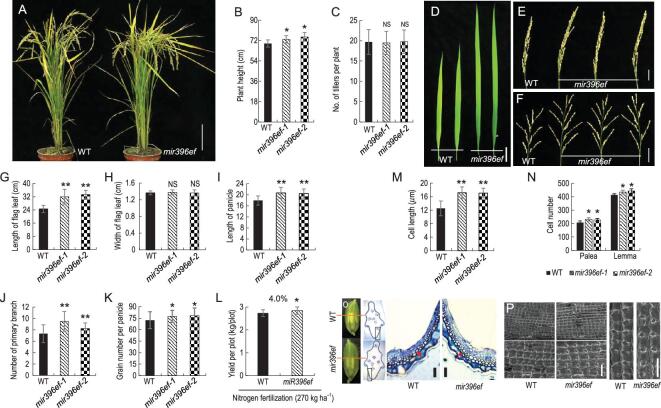Figure 2.
Morphological and growth phenotypes of mir396ef plants. (A) Gross morphologies of WT and mir396ef plants at maturity. Scale bar, 10 cm. (B) Plant height of WT and mir396ef. (C) Tiller number per plant of WT and mir396ef. Leaf (D), panicle (E) and panicle-branching (F) phenotypes of WT and mir396ef plants. Scale bars: 50 mm in (D); 30 mm in (E) and (F). Flag-leaf blade length (G), flag-leaf blade width (H), panicle length (I), number of primary branchings per panicle (J) and grain number per panicle (K) of WT and mir396ef plants. (L) Grain yield per plot of WT and mir396ef with nitrogen fertilization. One hundred plants (10 × 10) were cultivated in 2.0 × 2.0 (m) plots. (M) Cell length of grain spikelet hulls in WT and mir396ef plants. (N) Cell number of spikelet hull palea and lemma in WT and mir396ef plants. (O) Cross-sections of spikelet hulls of WT and mir396ef plants, and magnified view of the boxed cross-section area. The red line indicates the position of the cross-section. The rectangle indicates the position of the magnification of the hull. The red arrow points to the palea cells. Scale bars, 50 μm. (P) Scanning election microscopy images of the outer surface of glume in WT and mir396ef. Scale bars, 100 μm. Data are presented as means ± SD (n = 20 in (B), (C), (G)–(K) and (M); n = 5 in (L) and (N)). P-values (versus the WT) were calculated with Student’s t-test, two-tailed. *P < 0.05; **P < 0.01. NS, not significant.

